McKinsey Global Institute
Latin America used to be the world’s most prosperous emerging region, but it is on the verge of being overtaken by other regions that were long considerably poorer. It has lost ground since the 1980s despite reform initiatives because of sluggish growth and the unequal distribution of the gains of that growth. In this report, which focuses mainly on Brazil, Colombia, and Mexico, we examine two “missing middles” holding the region back: a robust cohort of midsize companies and a solid middle class with growing spending power. Both middles will need to be filled if Latin America is to have a new chance of generating sustainable growth that benefits the broad base of the population.
— Latin America’s average annual GDP growth of 2.8 percent between 2000 and 2016 has been slower than the 4.8 percent average of 56 other emerging economies, not including China. Almost three-quarters of Latin America’s growth came from expanding the number of workers rather than through productivity gains, which averaged just 0.8 percent annually, or one-fourth the productivity gains in emerging-market peers. The expansion of the working population as a share of total population will soon reverse, meaning that growth will increasingly depend on finding sustained productivity gains.
— Dynamic and competitive companies propel growth and well-paid jobs, but Latin American firms have yet to overcome a persistent polarization between a few very large companies and a long tail of small, unproductive firms. The missing middle tier of companies reflects the lack of dynamism: Latin America has fewer firms that have scaled up revenues above $50 million than higher-growth emerging economies do, which also translates into fewer large growth companies. The region needs more and larger companies willing to make bold investment in new technologies, including digital adoption, to boost productivity growth.
— The second missing middle is a cohort of upwardly mobile consumers whose rising incomes from productive jobs drive economic demand and investment. The poverty rate was halved to below 15 percent since 2000 but one-quarter of the region remains vulnerable because of high prices and a dearth of higher-productivity, higher-wage jobs. Rapid expansion of the workforce has held back wage growth, squeezing the middle class. In Mexico, average wage growth has been flat even in export-oriented sectors with rising productivity. In Brazil, the resource boom lifted wages, but taxes and the high cost of consumer goods have depressed purchasing power; cars retail for more than double their price in the United States. Latin America’s bottom 90 percent of earners accounts for less than two-thirds of domestic consumption, the lowest of all regions.
— Filling in the missing middles will require a comprehensive commitment to growth and inclusion that none of our focus countries has so far achieved. Brazil has seen a higher share of income go to labor and has expanded credit but is constrained by limited access to global supply chains and a protected “Brazil cost” on firms and consumers. Mexico’s market-opening reforms such as NAFTA boosted investment and productivity but did not translate into expanded domestic markets or sustained productivity growth. The region does have some success stories, including Chile, Colombia, and Peru, which have grown faster—albeit from a lower base for the latter two and a labor share of income growth that was no higher than the rest of the region.
— We estimate that Latin America could raise its GDP growth by 50 percent versus a baseline scenario to 3.5 percent annually in 2030, a gain of more than $1,000 per capita and $1 trillion in total, if the region converged toward the patterns of inclusive growth found among peers. Alongside more conventional policy approaches, digital adoption at scale could be a powerful new tool to achieve that goal, although it will not be a cure-all. Three priorities can help capture the productivity-enhancing opportunities. First is to establish a competitive business environment that reduces the cost of entry, improves access to finance, and cuts red tape, enabling small
and middle-tier firms to thrive. Second is to spread productivity gains to the vulnerable and middle classes through better-paying jobs, longer-term investments, and more participatory labor and consumer markets. Third, governments could undergo digital transformation themselves, improving delivery of public services and being more experimental. Government and business leaders have no time to lose if they are to meet the aspirations of millions of Latin Americans impatient for a more prosperous middle-class life.
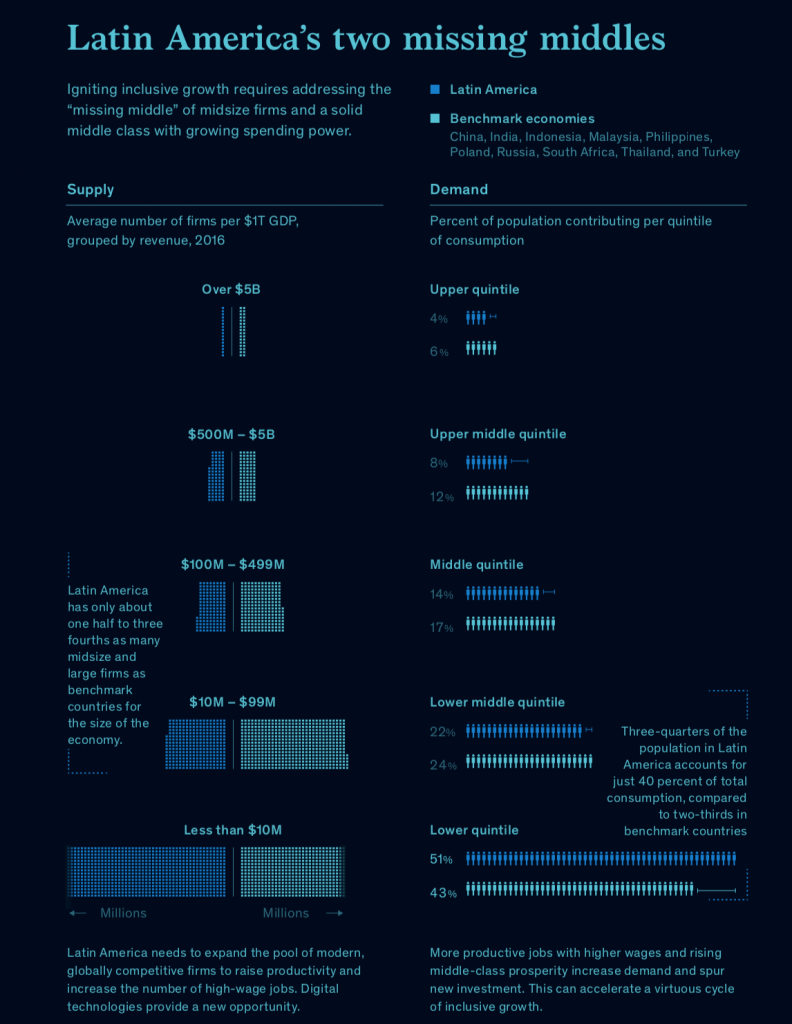
Executive summary
Latin America used to rank as the most prosperous emerging region in the world, thanks to an abundance of natural resources and the legacy of earlier industrialization. Yet over the past four decades, its erstwhile dynamism has seeped away. GDP growth has been weak and often volatile—and the fruits of that growth have not been broadly distributed to the benefit of citizens. Other emerging economies in Asia and beyond, meanwhile, have achieved more robust economic growth and raised living standards for much larger swaths of their population. As a result, when measured by the prosperity of consumers and households, Latin America is on the verge of being overtaken by other regions that were long considerably poorer (Exhibit E1).
The first decade of the 21st century showed progress toward faster and more inclusive growth, due to increasing macroeconomic stability, pockets of global competitiveness, the boost from commodity prices, and programs to transfer more wealth to lower income groups. However, this proved fragile, with reversals on poverty reduction and limited productivity growth in recent years.
In this report, we examine why this has happened and explore ways for the region to find its path back to broad-based prosperity. We focus mainly on three economies: Brazil, Colombia, and Mexico, which together account for 60 percent of Latin America’s GDP. All three countries, we find, are missing a middle—or, more precisely, two middles. One is a vibrant tier of midsize companies that grow, compete, and create better-paying jobs. They are needed to fill a persistent gap in the corporate landscape between a small number of large, established firms and a long tail of low-productivity and often informal small firms. While those at the top are relatively scarce, many of them have become globally competitive and raised the bar for productivity at home. But the middle—and the good jobs that go with it—is being squeezed by a lack of competitive dynamism to encourage innovation and investment, barriers to finance for small firms, and a challenging regulatory environment.
This business landscape has held back the creation of more productive and better-paid jobs, which in turn contributes to the other missing middle: the lack of a burgeoning middle class of consumers whose spending and saving could help fuel domestic demand and investment on a sustainable basis.1 That is needed in a region with, at one end, a wealthy elite that accounts for an exceptionally large share of consumption and, at the other end, a large cohort of vulnerable households that are no longer poor but that have yet to reach comfortable middle- class consumption levels. Firms base investment decisions on expected market growth, and the stalled middle class creates demand constraints that reinforce the squeeze on small and medium-size enterprises.
Filling in these missing middles will not solve all of Latin America’s economic challenges, but it will go a long way toward ushering in a more sustained era of broad-based prosperity to which its people aspire. No one factor explains their absence; some factors that contribute, such as low access to finance and poorly functioning labor markets, also exist in countries with relatively more midsize and large firms and middle-class growth. Nonetheless, the connection between the missing middles makes the challenges behind them harder to solve one at a time. New technologies may help to some extent. Above all, Latin America needs to spark a virtuous cycle of inclusive growth (see Box E1, “Inclusive growth in the context of a virtuous economic cycle”). Creating this cycle and preparing the groundwork for the adoption of digital at scale will in turn require focused efforts by both government and business leaders to create a more competitive environment for companies, share productivity gains more equitably, and improve public-sector efficiency.
In his speech accepting the 1982 Nobel Prize for literature, the Colombian novelist Gabriel García Márquez described Latin America as “a boundless realm of haunted men and historic women, whose unending obstinacy blurs into legend.” From an economic perspective, the obstinacy is not unwillingness to change, but the frustratingly disappointing results of the changes that have been made. All three of our focus countries have introduced reforms, which differ in nature but have similarly failed to deliver because they have not managed to accelerate growth nor altered the concentrated pattern of economic activity among both firms and households. That, in turn, has stoked political and social tensions in the region.
Latin America faces a dual challenge of slow GDP growth and unequal
distribution of the gains of that growth
Growth in Latin America has been slower and more volatile than in other emerging economies, and the unequally distributed gains from that growth have failed to ignite the domestic economy and sustain growth.
Labor expansion more than productivity gains has fueled growth in the region
GDP growth in the region averaged 2.8 percent annually between 2000 and 2016, far lower than the 4.8 percent rate in 56 other emerging economies in the same period (not including China, which grew at twice that pace). Among Latin American economies, Peru grew most strongly, averaging 5.2 percent per year. Of the three countries that are the focus of this report, Colombia performed best, with average growth of 4.2 percent. Brazil’s growth rate, at 2.4 percent, was closer to the regional average, while Mexico’s was weaker, at 2.1 percent. In addition to being weak, regional growth has been volatile, buoyed by the commodity boom, which saw prices for resources such as oil, mineral, and some agricultural products surge, only to fall back sharply.2
The largest driver of GDP growth in Latin America has been expansion of the labor force, the result of a demographic boom and increased participation of women.3 The workforce grew by 66 million workers between 2000 and 2016, and this expansion accounted for 72 percent of the region’s overall GDP growth. The demographics are now changing: fertility rates in Latin America declined from 4.2 in 1980 to replacement rate in 2015. This means the region will need to count on productivity growth rather than labor expansion as the main driver of GDP growth.4 This would bring Latin America into line with other emerging economies, where labor expansion has been a much smaller factor in driving GDP growth—37 percent on average in 56 countries excluding China—and considerably less important than productivity growth.
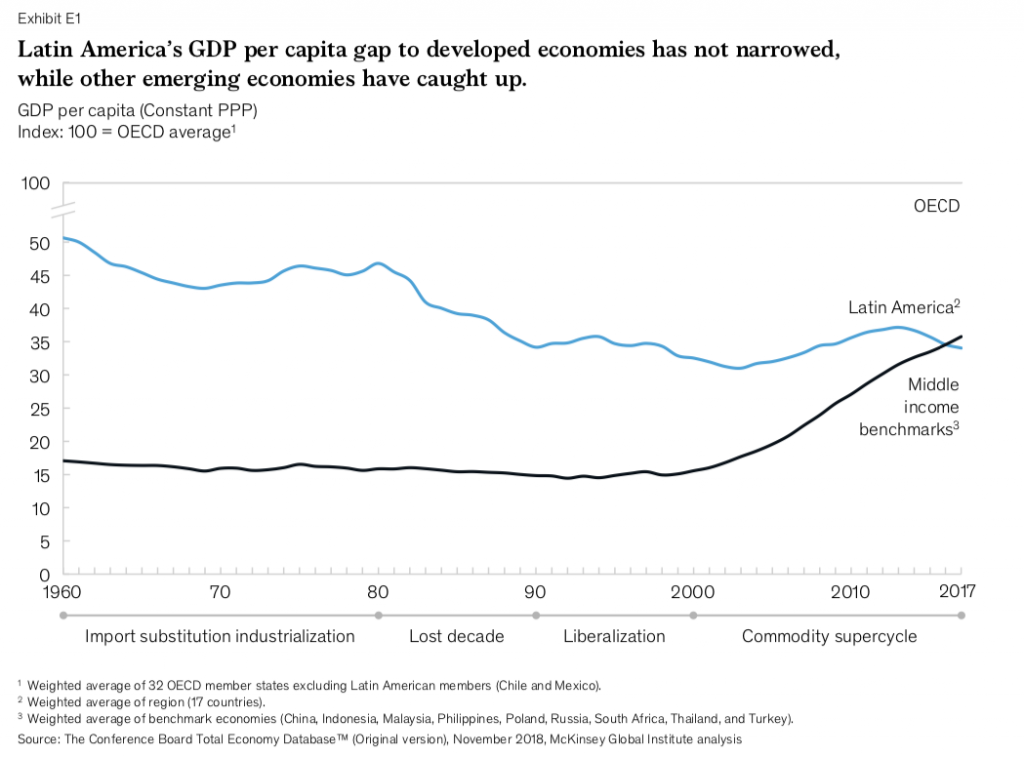
A sharp reduction in poverty is a notable success, but more than 150 million people in Latin America remain vulnerable
Since 2000, 56 million people—or more than 40 percent of Latin America’s poor in 2000— have crossed the $5 per day absolute poverty threshold, reducing the overall proportion of people in poverty to 13 percent of the total from 27 percent.5 Both the income boom from rising commodity prices and governments’ pro-poor policies propelled this movement.
These include conditional cash transfer programs in Mexico and Brazil, which tie transfers to keeping children in school or making preventive healthcare visits.6 Bolsa Família, the Brazilian program launched in 2003, now reaches 14 million households, about one-quarter of the population, and helped bring down the proportion of those living in extreme poverty from 10 percent to 4.3 percent over a decade.7 The poverty-reduction momentum has slowed in
the wake of the 2008 global financial crisis and the end of the commodity boom, however. By
2018, poverty and extreme poverty rates had risen above the levels of a decade earlier.8
While poverty has been reduced since 2000, the slow expansion of higher-productivity and higher-wage jobs has left many vulnerable. No longer officially poor, they have not yet reached comfortable middle-class spending patterns—meaning they are still unable to afford goods and services that go beyond basic needs and may not have access to credit—and remain at high risk of falling back into poverty during a recession or in the event of a health or employment crisis.9 More than one-third of the region’s population lives on less than $11 per day, based on purchasing power parity, including 152 million people in the “vulnerable” category of $5 to $11 per day (over 60 percent from Brazil, Colombia, and Mexico). More than 60 percent of the population lives on less than $20 per day (Exhibit E2).
The bottom 90 percent in Latin American households consumes just 64 percent of the total, the lowest share in the world
Consumers crossing over to the middle class have more money and more access to credit to spend beyond basic necessities and they tend to spend a higher share of their income than more affluent people. However, social inequality marks consumption patterns in Latin America. The bottom 90 percent of the income distribution in Latin America—the region’s poor and vulnerable, and most of the middle class—accounts for just 64 percent of domestic consumption. This is the lowest share in the world, akin to that in Sub-Saharan Africa but substantially lagging behind other regions, where the bottom 90 percent consumes about 70 percent or more of the total (Exhibit E3).
A missing middle of dynamic midsize companies reduces competition
and innovation
The business landscape in Latin America is polarized. The region has some powerful companies, including some with very high productivity that have successfully expanded from their strong local base to become global companies or “multilatinas”—regional powerhouses operating across Latin America. They include AB InBev, America Movil, Arcor, Bimbo, CEMEX, Embraer, FEMSA, Techint Group, among others. By comparison with large firms in other regions, such companies are fewer in number and less diversified beyond energy, materials, and utilities. At the same time, Latin America has a long tail of small, often informal companies that collectively provide large-scale employment, but whose low productivity and stagnant growth hold back the economy.

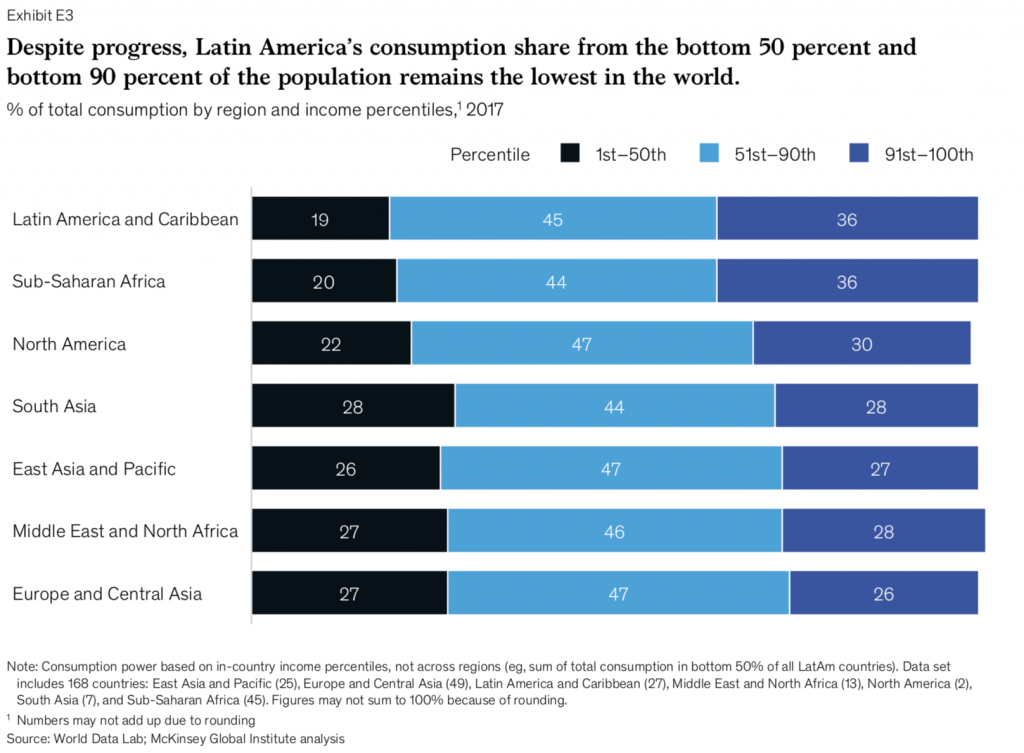
Missing is a cohort of vibrant midsize companies that could bring dynamism and competitive pressure to expand the number of productive and well-paying jobs in Latin America, much as these firms do in many high-performing emerging regions. Exhibit E4 shows how much less prevalent large and midsize companies (over $50 million in revenue) are for the size of the Latin American economy compared with peers elsewhere. Given their relatively small number, these large firms account for less than three-quarters of the total revenue relative to GDP.
Latin America’s large companies can face less dynamic domestic competition than peers in other regions
The missing middle of companies reduces competitive pressure on large incumbents. In comparing Latin American companies with large firms in a benchmark set of ten countries— China, India, Indonesia, Malaysia, Philippines, Poland, Russia, South Africa, Thailand, and Turkey—we find several indications that the competitive dynamics are less powerful, but with important variation across countries.10
First, the number of public companies with revenue of more than $100 million is smaller proportionately in Latin America than in high-performing Asian countries. Whereas over 80 percent of publicly listed companies of this size in our benchmark countries crossed the $100 million threshold since 2000, the proportion is less than 60 percent in Brazil and Mexico. Colombia’s much smaller corporate sector has been more vibrant, with these firms accounting for 81 percent since 2000.
Second is the degree of turnover at the top of the rankings. Top-quintile companies with more than $500 million in revenue in the best-performing emerging economies have a hard time getting to the top and staying there: less than half of top-ranked firms in economic profit—that is, returns above the cost of capital—in one cycle were still at the top in the next cycle.11 In Latin America, we see a distinction between Mexico, where two-thirds of the top-quintile firms in terms of economic profit remained in place over the past 15 years, whereas in Brazil, only one- third did, indicating a more vibrant market. Other economies in the region tend toward the average of our benchmarks.
Third, these dynamics have correlated with concentrated gains in some cases. Some recent research shows that Latin American firms have been able to command larger and more stable markups on their products, dating to the 1980s. That was even before the rise of the “superstar” phenomenon among large global firms that are capturing an ever-larger share of profits and pulling away from their peers. We also find that midsize and large firms’ profit margins in our three countries are higher across most sectors since 2000 than in our benchmarks. The variation in economic profit is also higher: the top quintile economic profit is higher and the lowest quintile economic profit is lower (more negative) than in the benchmark economies. Trade protection, a legacy of earlier import substitution policies, also continues to contribute to high consumer prices in a number of industries.
The causes of this firm distribution and dynamics are rooted in common legacies of import substitution that favored a few private licenses or large state-run firms in many sectors. Other reasons are differing ways in which state companies were privatized and, especially in Brazil’s case, tax and compliance-heavy regulation that favors either large scale or informality. Unequal access to finance, weak infrastructure, and high input costs also squeeze the middle. The result is a weak level of innovation and specialization needed for future growth. Brazil, Colombia, and Mexico rank below their development level on innovation indices; they have one-quarter to one-third of the digital diffusion of the United States, for example. Research and development investment in the region is relatively low, at just 0.3 percent and 0.5 percent of GDP for Colombia and Mexico, respectively, although it reaches 1.2 percent for Brazil. This compares with about 1 percent for benchmarks.13
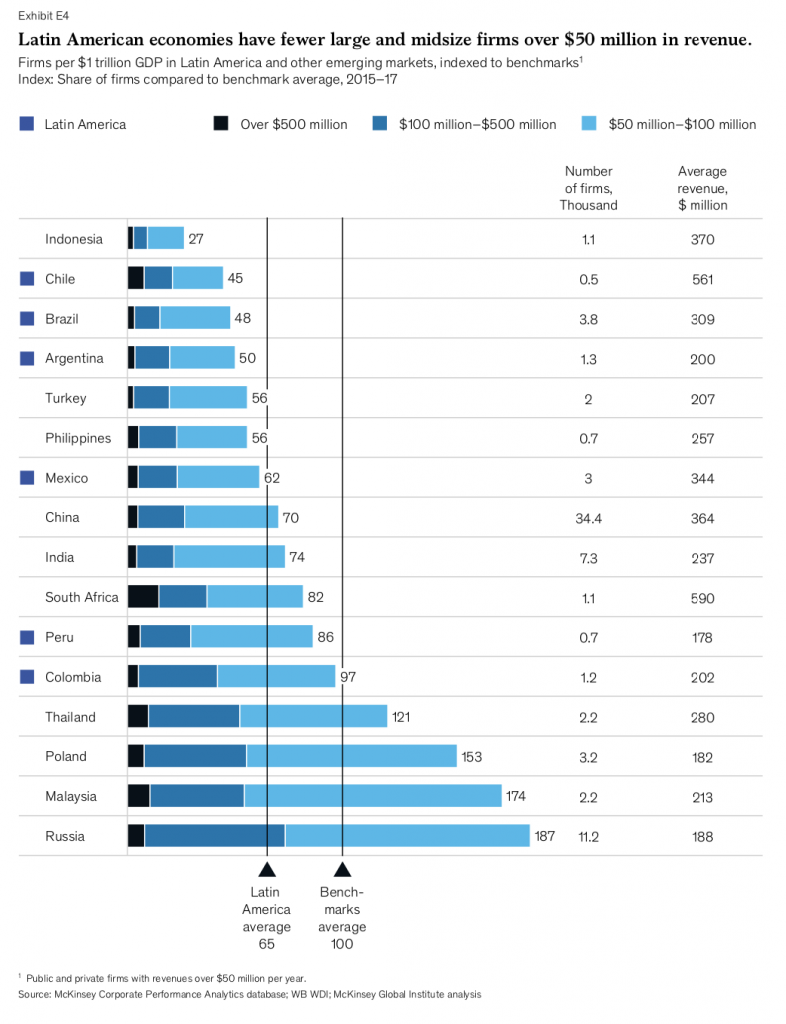
Much of Latin America’s labor force is trapped in a long tail of small, unproductive, and often informal firms
The other side of this dual economy is a multitude of small companies, many of which operate outside the formal economy (as do some midsize and even large firms). These small companies tend to have low productivity and absorb a significant proportion of low-skill workers. They are most concentrated in sectors like retail, construction, and agriculture. Brazil has had the most success in reducing the level of informality in the overall labor force: the rate fell below 50 percent in 2015–16. Mexico and Colombia have much higher rates, of 57 percent and 62 percent, respectively, according to household surveys in each country.
Retail highlights how the long tail of small companies drags down overall productivity. In Mexico, for example, small retailers employ two-thirds of the sector’s workforce, or 6.6 million workers, but value added per worker is only about one-seventh that of large and more efficient retailers (Exhibit E5).
To increase our understanding of the long tail of small businesses and its resistance to change, we conducted a survey of 3,000 workers—informal, formal, and self-employed—in Brazil, Colombia, and Mexico. It suggests that a majority of workers see self-employment as the main fallback option when wage employment is not available: 70 percent of respondents said temporary or informal self-employment was a viable option in a time of financial uncertainty. Such uncertainty is high, with 28 percent of all workers saying they expected to leave their job in the next 12 months.
The survey also highlights the constraints of small business. Some 28 percent of the sample were self-employed, of which about half were formal businesses. Only one in four respondents indicated that they had access to the credit needed to expand their businesses— but two in three said they would like to expand if they could.
A missing middle of consumers holds back domestic demand and
incentives for investment
The other missing middle is a cohort of upwardly mobile consumers whose rising disposable
income helps drive economic demand and investment on a sustainable basis. Furthermore,
compared to benchmarks, a higher proportion of the consumption growth that has
occurred in Latin America has come from expanding population rather than rising per capita
consumption. As noted, many of those lifted out of poverty remain vulnerable and have not
reached a comfortable middle-class existence. For this cohort, the main path to sustained
and rising prosperity comes from access to productive, well-paid jobs—which have been too
scarce to meet the needs of the rapidly expanding labor force in the region. As the supply-
side challenge of a missing middle of companies has constrained the expansion of attractive
jobs with higher wages and opportunities to build skills, it has contributed to the demand-side
challenge of a missing cohort of middle-class consumers with sufficient income to sustain
robust domestic demand. The sluggish demand acts as a serious drag on the economy. It
limits the growth of markets for domestic businesses that constitute the majority of jobs in a
modern economy. It also holds back the development and provision of more complex goods
and services, which in turn could strengthen the economy by encouraging investment.
The growth patterns providing the context for this missing middle differ among our focus countries. In Brazil, the commodity boom led to rising wages and helped draw workers from small-scale agriculture to low-skill jobs in small establishments with below-average productivity. In Mexico, by contrast, wage growth has been strikingly weak and at times negative, even in expanding, high-productivity sectors such as automotive.
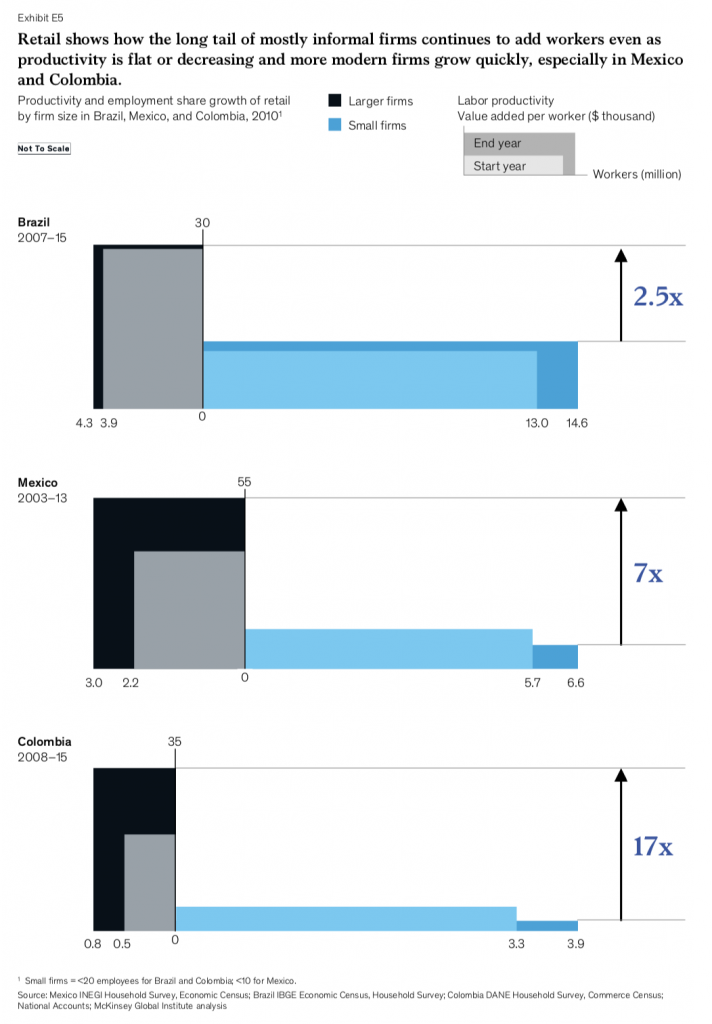
Consumption has grown with expanding population, exports are not filling the demand gap, and both investment and savings are relatively low
Household consumption represents the biggest share of GDP expenditure in any economy and 64 percent in Latin America, yet it has expanded only slowly, contributing 1.9 percent to GDP growth compared to 2.7 percent in our emerging-market benchmarks. Furthermore, compared to benchmarks, a higher proportion of the consumption growth that has occurred in Latin America has come from expanding population rather than rising per capita consumption. Since the turn of the millennium, per capita consumption growth in Latin America has been just 1.8 percent, less than half the 4.3 percent in benchmark countries. Colombia is high for the region, with per capita consumption growth since 2000 of 2.8 percent, while Chile and Peru are outliers at 3.7 and 4.2 percent respectively (Exhibit E6). In Mexico, the reverse is true: per capita consumption growth accounted for less than the population growth’s contribution, consistent with low wage growth. This matters because consumption patterns change as incomes rise, with markets for more complex goods and services growing to provide new growth opportunities for business.
The purchasing power of Latin American consumers is further taxed by the high cost of many consumer goods. Trade barriers continue to raise local prices above global ones, including for basic goods such as food. Similarly, taxes can limit the purchasing power of those most ready to spend. In Brazil, value-added tax represents 40 percent of the total tax burden, compared with 32 percent of the tax burden in Organisation for Economic Co-operation and Development (OECD) countries on average.14 Taxes on cars approach 50 percent of the cost to consumers. Counting all taxes, the lowest decile ends up paying 32 percent of income in taxes, compared with 23 percent for the middle decile and 21 percent for the top decile.15
The difficulty in obtaining consumer credit and underdeveloped digital services in finance and retail compound the plight of the vulnerable. Financial inclusion is limited, with less than 50 percent of people in Mexico and Colombia having access to bank accounts. This restricts the ability of households to make the most of their incomes by borrowing and saving. Only 6 percent of sales in Brazil in 2017 took place online, for example, about the same proportion as in India and Indonesia, but substantially lower than in China (16 percent) and South Korea (13 percent). However, digital disruption is starting to appear. In Colombia, notably, a startup called Rappi is providing on-demand delivery of items such as groceries and medication and has become one of Latin America’s first “unicorns”—a startup with a valuation of at least $1 billion. The Argentine digital marketplace MercadoLibre is also gaining ground and spreading across the region.
Exports could help fill this demand gap, providing the incentives and markets that companies in Latin America need to invest and broaden their production. However, with the notable exception of Mexico, exports play a smaller role than in the other emerging economies we use as benchmarks; exports in the region account for just 22 percent of GDP compared with 36 percent in the benchmark countries. Mexico has achieved a much stronger export performance since the establishment of NAFTA. Its exports of goods and services rose from 25 percent of GDP in 2000 to 38 percent in 2017. However, the benefits of its export growth have not spilled over into the domestic economy more broadly.
Expectations of future demand are a main reason for companies to invest in larger and better production capabilities. With limited access to export markets and slowly growing domestic demand, Latin American economies have maintained rates of investment below those of their peer economies. Latin American and Caribbean investment in 2016 amounted to 19 percent of GDP, below the global average of 24 percent and the investment rate among East Asian emerging countries of 41 percent. Of our three focus countries, only Colombia reached the global average, recording a rapid rise from 13 to 24 percent between 1999 and 2015, before dipping.
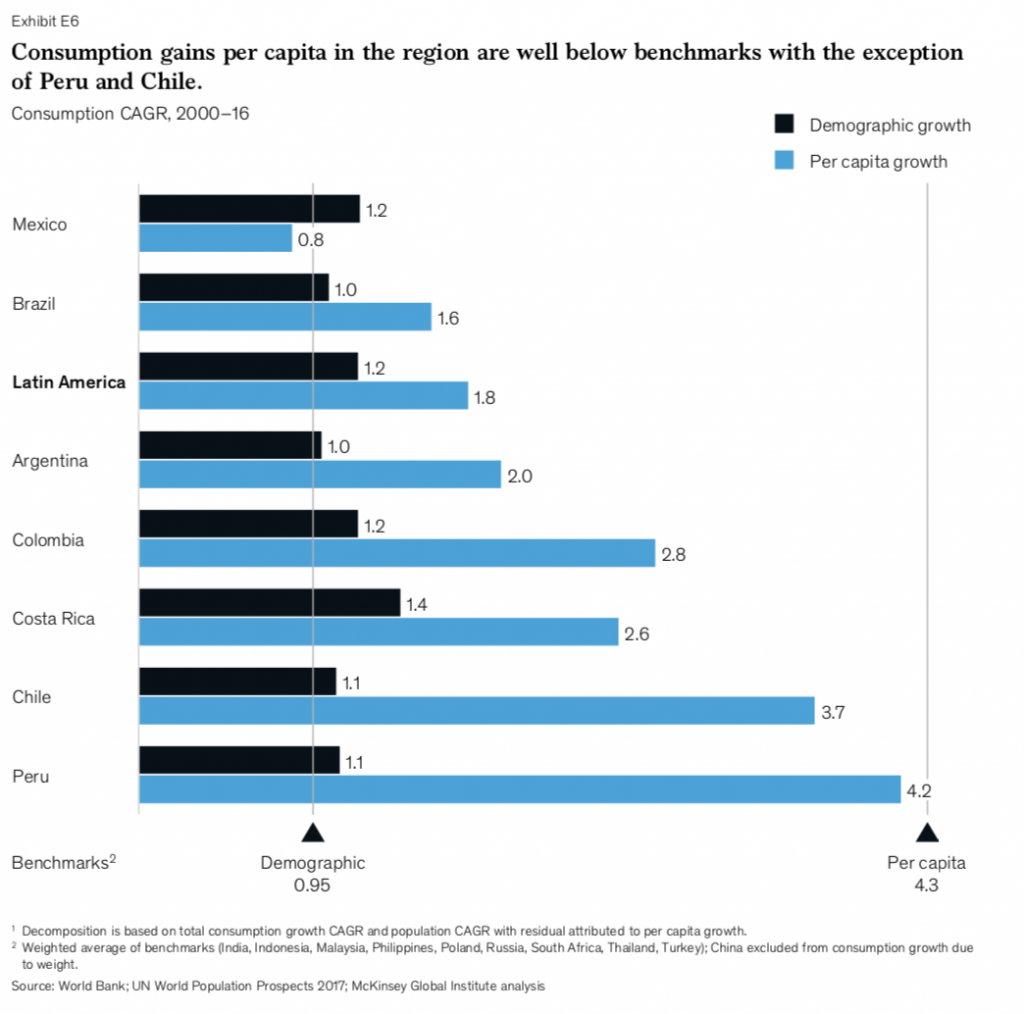
Income is not flowing through to expanded domestic consumption for different reasons: A comparison of Brazil and Mexico
The flow of income to expanding domestic consumption can slow for different reasons. Brazil and Mexico provide two examples. In Brazil, social policies, minimum wage increases, and a credit expansion during the commodity-cycle upswing all gave a boost to the domestic
market—but it was not sustained. Employed labor income accounted for 57 percent of gross
income growth, due mostly to expansion of low-skill retail and other services. The demand
boom was not matched by supply-side reforms to raise productivity, however. Moreover,
high consumer prices and expensive credit continued to tax the purchasing power even of
those with rising incomes. The benefits faded away through inflation and macroeconomic
instability once the commodity boom ended. The demand boom was thus unsustainable
because it was not supported by supply-side initiatives or a macro environment conducive to
private investment.
Mexico, by contrast, focused on supply reforms and access to external markets, boosting productivity among the large modern segments of many industries by as much as 5.6 percent in the 2000s.17 Yet domestic demand has lagged. Productivity in the long tail of small industries did not improve and, unlike in Brazil, the gains did not feed through into broad- based wage growth; rather, they accrued mainly to the profit share of income. For example, while manufacturing productivity increased by an average of 1.7 percent annually between 2005 and 2015, average wages were stagnant. Given that a higher share of wage income is spent (rather than saved), this limited the multiplier potential of the productivity gains to translate into a more sustained source of domestic demand expansion. Domestic market growth was thus limited, crimping incentives for investment. The middle lost out amid these changes.
The Mexican auto sector provides one striking example of the divergence between productivity growth and wages. Production has grown at an annual average rate of 7 percent since 2006, and after doubling in a decade, labor productivity now ranks with that of the top producers in the world. Labor income gains have come from added workers at a wage level that is 1.6 times the national average, yet the average wage of Mexican autoworkers declined in the same period. By comparison, South Korea at the same point in its auto industry development saw a 58 percent increase in sector wages over the corresponding ten years of productivity growth.18
In Colombia, the patterns of growth since the turn of the century have been more inclusive. Wage growth averaged more than 2 percent annually, exceeding productivity growth and reflecting productivity gains across sectors. Some six million workers joined the workforce between 2000 and 2015, with disproportionate gains for women. However, this rapid expansion slowed wage growth compared with some peers. For example, Thailand grew at about the same rate in this period but nonetheless achieved wage growth of 3.7 percent, almost double that of Colombia, thanks to substantial productivity gains and a tighter labor market.19
Filling in the missing middles to capture the next wave of growth
If Latin American economies were able to fill in and strengthen the missing middles, thereby establishing a virtuous cycle of inclusive growth, the potential reward would be substantial. Using a macroeconomic simulation that assumes conservative growth in productivity is matched by increased labor shares and consumption in line with more inclusive countries, we find that achieving such a growth cycle could lift GDP in the region in 2030 by 50 percent above a baseline scenario that factors in current trends, including reduced labor force expansion. That would amount to an increase per person of more than $1,000 per year,
or a $1 trillion incremental boost to GDP in 2030. Obtaining that prize will be challenging. Governments and business leaders will need to embrace a growth-focused policy agenda that addresses the missing links of past reforms.
Even in a time of social and political tensions, Latin America has a new opportunity to revitalize inclusive growth—and new tools to achieve it: digital technologies that can raise productivity growth and develop the missing middles, if embraced and adopted at scale. Digital entrepreneurship is already on the rise, with new platforms and applications from e-commerce to digital finance springing up across the region; several digital startups have achieved valuations of $1 billion valuation or more.
Digital technologies can help directly address some of Latin America’s challenges around the missing middles. While not a “silver bullet” or cure-all, the technologies can make it easier for companies to open businesses, register property, and file taxes over the internet, reducing the cost of red tape. Digital can facilitate more efficient markets from land and jobs to local services. Digital platforms make it possible for small and midsize companies to become “micromultinationals” able to compete with much larger competitors by offering their goods and services through online marketplaces regionally or globally. Critically, digital can and is already creating new, more productive jobs in Latin America—and the potential productivity boost it could give to the region’s economies as a whole could offset the drag from its changing demographics. At the same time, these technologies present potential risks for inclusive growth in terms of job displacement and further concentration of profits.
Three priorities will be needed to lay the foundations for a pro-growth, inclusive agenda for the region and make it better able to embrace digital disruption
First is the need to create efficient markets and a competitive business environment in which digital can thrive, innovation is rewarded, and opportunities are created for all, especially squeezed firms in the middle. That will mean using digital tools where available to cut red tape, improve access to finance, and reduce barriers to entry and growth that reduce dynamism and performance pressure.20 Second, policy shifts will need to create more participatory labor and consumer markets that spread productivity gains to the vulnerable and middle classes. If Latin America is to boost prosperity for all, productivity gains must flow to rising incomes for workers as they increase in skill level and to firms well placed to reinvest in their people, technology, and communities. Third, government itself can leverage digital platforms to raise public-sector efficiency and improve the delivery and cost of public services. Institutions will need to adapt and shift focus from protecting and regulating the status quo to encouraging new investment and experimenting with new delivery solutions.
Such changes will make Latin America better able to harness digital technologies, which could serve as a powerful source of productivity and growth. For this, digital-focused policies will also be needed, including building out broadband infrastructure, adapting regulation to
a digital age, promoting digitization of government and society more broadly, and investing in the skills needed to bring about large-scale digital transformation. While the changes may be led by digital companies and technologies, they will extend to non-digital parts of the economy, too. Many countries in Latin America have already started on this path; if that energy can be maintained and built out, the region may be ripe for a Digital Spring.
Latin America has a new chance to rewrite the course of inclusive growth in the region, but the context requires immediate action. Navigating the digital wave and reigniting productivity growth will require an urgent collaborative effort across sectors at a time when declining fertility poses risks to the region’s economic prospects. Beyond disruptive global forces, now more than ever the region’s future is in its own hands. Solutions are available. A comprehensive approach combining supply-side and demand-side reforms is needed to build competitive capabilities for growing firms and ensuring that the broad base of the population benefits from the gains. This is not just a task for governments; a constructive role for business leaders is also called for. At a time of rising public disgruntlement, the people of Latin America need the prospect of a brighter economic future in which they can believe.
Authors
Jaana Remes, San Francisco
Andrés Cadena, Bogotá
Alberto Chaia, Mexico City
Vijay Gosula, Salvador
Jacques Bughin, Brussels
James Manyika, San Francisco
Jonathan Woetzel, Shanghai
Nicolás Grosman, Buenos Aires
Tilman Tacke, Munich
Kevin Russell, San Francisco
Source: https://www.mckinsey.com/~/media/McKinsey/Featured%20Insights/Americas/Latin%20Americas%20missing%20middle%20of%20midsize%20firms%20and%20middle-class%20spending%20power/MGI-Latin-Americas-Missing-Middle-Executive-summary-May-2019.ashx

 Português
Português